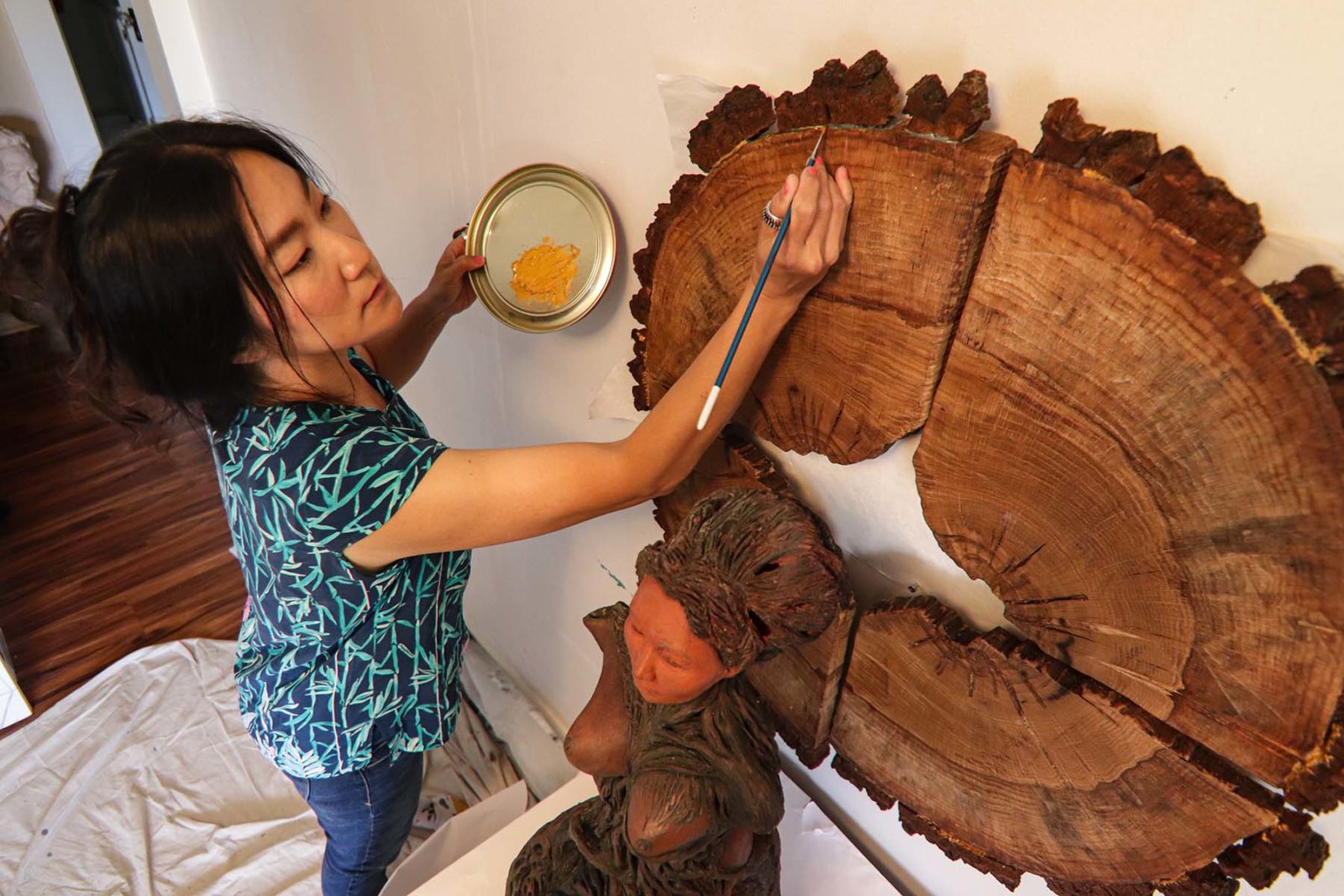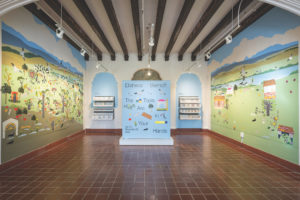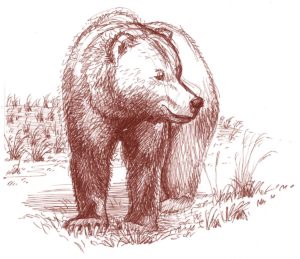A valley oak tree is dying on a hill in Walnut Creek. The year is 2019 and a massive October windstorm is raging across the city. At 325 years old, the oak is the city’s oldest tree and stands nearly 100 feet high. On good days, the green leaves on its branches glimmer, reflecting the bright beams cast by the sun into the surrounding area, providing anything living with the warmth of its filtered touch. But tonight, it stops. The ground loosens, the wind blows, and the tree comes crashing down, the ending to a long life.
As the tree lay upended on the hill, curators from the Bedford Gallery in Walnut Creek saw an opportunity to ask artists to consider the meaning of a tree’s life and death. They cut pieces from the tree and in late 2020 distributed them to 64 Bay Area artists to work with in creating original art. The resulting exhibition, If a Tree Falls: Art of the Boundary Oak, opens Saturday, October 30.
Remember, they are an exotic species in the Western United States, and are rapidly increasing their geographic range and range of habitats. Are they outcompeting or excluding native species in the process? How would we know? We have done almost nothing to monitor changes in the assemblage of mushroom species in areas before and and after the incursion of death caps.
Further Reading
Pringle et al, “The ectomycorrhizal fungus Amanita phalloides was introduced and is expanding its range on the west coast of North America,” Molecular Biology 2009
Lockhart et al, “Simultaneous emergence of multidrug-resistant Candida auris on 3 continents confirmed by whole-genome sequencing and epidemiological analyses,” Clinical Infectious Diseases 2017
Battalani et al, “Aflatoxin B1 contamination in maize in Europe increases due to climate change,” Scientific Reports 2016
“If a Tree Falls: Art of the Boundary Oak” exhibition will be showing at Bedford Gallery from Oct. 30, 2021 through February 13, 2022. 1601 Civic Dr., Walnut Creek. Bedfordgallery.org
The artists work across various mediums, including painting, printmaking, carving, and sculpting, and each piece of art has been made solely for the show and—most importantly—will contain pieces of the fallen “Boundary Oak” (The term “Boundary Oak” comes from the fact that the tree lived inside Boundary Oak Golf Course.)

I spoke with one of the exhibition’s participants, San Francisco-based artist Tsungwei Moo, to learn more about the show and the process of creating art out of discarded matter. Moo arrived in the United States from Taiwan in 2005 and has practiced art ever since, specializing in painting and sculpting. Her work has won various awards and has been displayed in galleries and museums throughout the Bay Area, as well as inside the San Francisco Muni system’s buses and trains. Recently, as part of United Airlines’ “Her Art Here” contest, Moo had her work painted on a Boeing 757 plane. She’s also taught summer art classes at Yosemite National Park since 2012. I met with her at her home on a sunny afternoon in late September.
Tsungwei Moo occupies the top floor of an old white Victorian building on Greenwich Street, in the heart of Russian Hill. Her art studio, which is her living room, is a small room with oil cans, paint brushes, and large sheets of paper strewn all over the wooden floor. A desk and chair take up a corner, next to several buckets of paint and the room’s only window (which gives a beautiful view of Coit Tower and the Bay beyond). Four large pieces of an oak tree—the “Boundary Oak” from Walnut Creek—lie dead center in the room. Together the pieces form a circular shape, which, along with the rings on their smooth surfaces, indicates to me that they were cut from the tree’s trunk and sanded down. Remnants of the oak’s outer bark render the rims of the pieces jagged, reminding me of the spikes on a coronet. Overall, the object looks like a stylish, round, wooden coffee table with no legs.
Moo is in the middle of putting the finishing touches on the tree piece for the upcoming Bedford Gallery exhibition. She sits cross-legged on the floor, smoothing out each part with oil.
“I’m using walnut oil to massage each quarter slice,” Moo says. “This is to tone down the color and give the wood nutrition. Otherwise, the wood is going to keep cracking — actually, the wood, after years, is going to crack anyway. It’s just a part of nature.”

In 2017, Moo’s boyfriend Ricardo was shot and killed during a robbery in Jamaica. A year later Moo used discarded gun parts from a gun buyback program to create a painting that addressed the horrors of gun violence. “Art for Peace” was displayed in Vallejo’s Temple Art Lofts. “Different people were killed by those same guns,” she says. “I repurposed those weapons into art to make people aware of gun homicides. The difference with this one [the tree piece] is that I’m reusing wood that has been destroyed, and giving it a second chance at life through art.”
Moo’s mother died in September 2019, one month before the Boundary Oak fell. When Moo heard about the call for artists for the Bedford Gallery exhibition, she was still dealing with the heavy toll of her loss.
“After my mom passed away, all I could think about was ‘Where are we going?’ ‘Where does the spirit go?’ ‘When life ends, what is going to happen next?’” Moo says. “So, after the 325-year-old oak tree died, it dawned on me — growth continues to take place even after death; the mushroom grows on the dead wood, while animals eat those parts. The tree may have died, but it still provides life and continues to live but in a different form. That’s why this project has meaning for me — these four broken pieces of wood come together to form a rebirth.”
Directing the sadness from her mother’s death into something artistic isn’t easy for Moo, especially when the work materials are as fragile as four two-year-old pieces of a broken tree. To put them together, Moo used a 600-year-old technique called Kintsugi, the Japanese art of assembling broken pottery pieces back together with gold. Kintsugi is founded on the idea that in embracing imperfections, the user can create an even sturdier, more attractive art piece. The method renders every break special and, instead of repairing an object like new, highlights the flaws as a part of the design. For Moo, that meant filling in the cracks in each wood piece with gold paint, as well as joining the four pieces together with gold wood glue to make them “whole” again.
The other component to Moo’s artwork for the exhibition is a sculpture that will accompany the oak tree piece. The sculpture is of a naked woman being erected from the roots of a tree—a stump serves as the base; dozens of thick roots rise from the base and contort into an upper body, stomach and shoulders; the roots go on to form the body’s neck, extending to the head and hair. The only smooth parts are the woman’s breasts, face, and backside. The sculpture, altogether, resembles a skinless female body dipped in bronze. The woman, or “goddess,” as Moo describes her, is “kind of like a self-portrait,” she says. “I’ve always had a really deep connection to trees. I love nature.” The sculpture was iron washed, which enhances the tree parts by giving it an overall rustic brown color. Still a work in progress, Moo plans to add more details to the sculpture, including painting light green moss on different parts of the body. “She [the goddess] is a part of the tree; she’s a spirit; she’s a tree transformed.”

Altogether, Moo’s artwork for the Bedford Gallery exhibition will consist of the goddess sculpture and the conjoined oak tree pieces. The latter is set to be placed behind the former, serving as a type of “halo” for the goddess, Moo says. The working title for her artwork is “Unbound Goddess,” which, according to her, is in reference to the passing of life, the point where “you no longer have to carry the heavy weight on your shoulders. Where everything is unbound.”
When I ask Moo what she hopes viewers will take away from her artwork, she tells me it’s hard to say. Everyone has their own life experiences, and she wants them to feel their own story in the subject. For her, the art helped relieve the grief she experienced after the passing of her mom. She hopes viewers will at least experience that same type of comfort.
“Sometimes when I create something, I don’t know why I create it; it just comes out of me,” she says. “And when I look back, I realize ‘Oh, I did it because of my life situation, or because something happened.’ So, when this project started, I didn’t know what I was going to come up with. I just kept working, and eventually I found the answer.”





